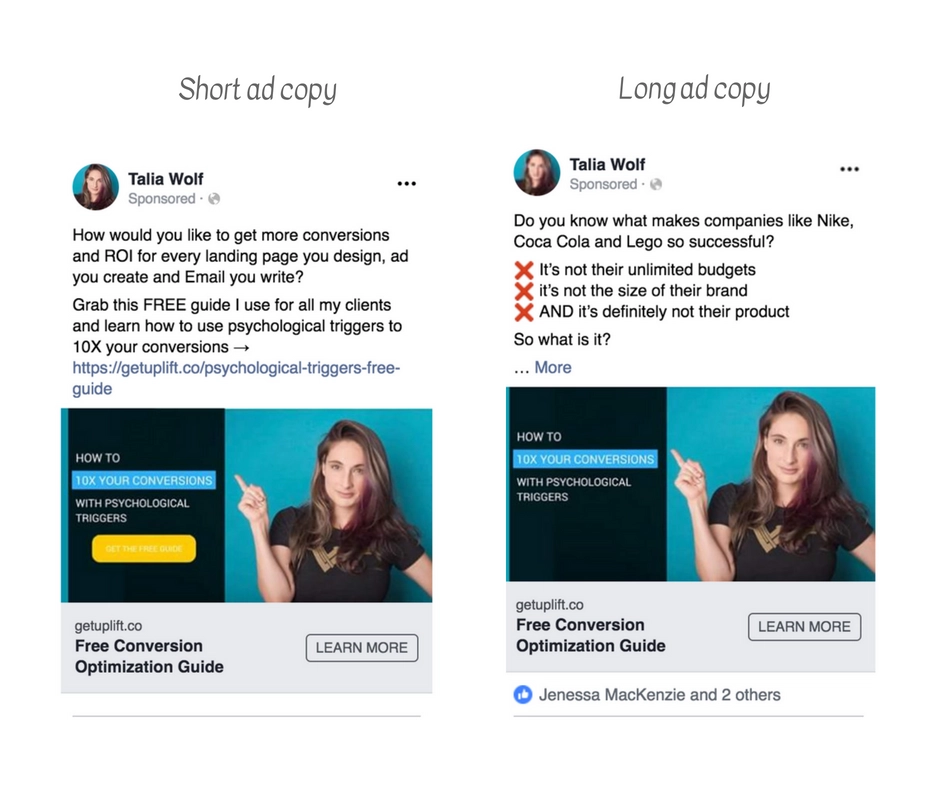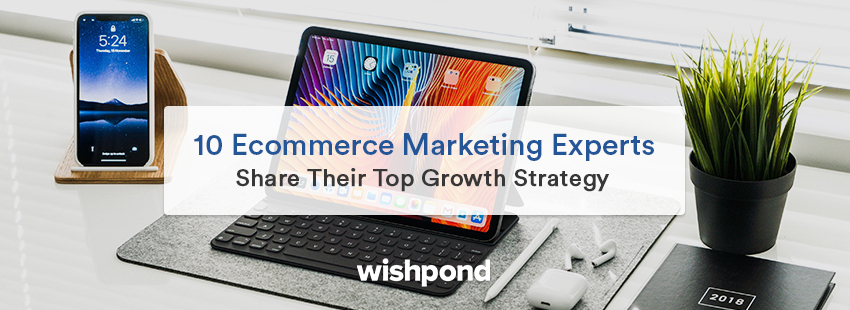I sought out ten of the top ecommerce experts to get their top strategies for growing an ecommerce business.
Now, many of the experts in this article may be unknown to you, but that’s because they’re the people on the front lines of ecommerce marketing.
These aren’t the influencers making six figures at a marketing conference. They’re the people who went to that marketing conference and then put the strategies into action.
These are the testers, the optimizers, the consultants. These are the people who run your competitor’s marketing strategy.
Here are their 10 top strategies for growing an ecommerce business online.
#1. Kaleigh Moore’s Top Ecommerce Growth Strategy: Check In
Kaleigh’s right, the following strategy is one of the most overlooked growth tactics in the ecommerce space.
There’s something very final in an ecommerce purchase. Many marketers devote 95% of their energy to that first “buy.”
And then they move on, missing out on a huge avenue for growth.
Here’s what she has to say:
There’s one thing that I’m always shocked that, in general, freelancers and business owners don’t do very well.
Following up. The classic check in or touch base.
You know: It’s that little nudge of an email that essentially says, “Hey, remember me? I’m here and open for business if you (or anyone you know) needs me right now. Let’s work together again.”
It’s so simple…and yet so many people fail at this.
They forget to do it, and then when things get slow, they think, “CRAP! My business is going to fold. It’s all over. This is the end.”
When in reality, they probably have a list of people they haven’t checked in with in a while who need help. They just forgot/are too busy to reach out on their own.
If you haven’t heard from an old customer in a while, that’s not to say they don’t need you, like you, or even miss you.
They probably just have 120,523 things to do and it’s your job to be proactive and say, “Hiiiiii, I’m still here if you need me and also here are some ideas of things I could do for you.”
Following up, checking in (whatever you wanna call it) has helped keep my business sustainable (and growing!) over the past five years. And it only takes a few minutes to do.
Read more on Kaleigh’s top ecommerce growth strategy here.

Kaleigh Moore is a freelance writer specializing in ecommerce marketing. Previously a PR manager for a non-profit organization and owner of her own ecommerce business, she now writes for Copyhackers, Kissmetrics, ConversionXL and SumoMe. Her portfolio and blog can be seen at KaleighMoore.com.
#2. William Harris’ Top Ecommerce Growth Strategy: Build a Community
It’s never too early to build a community. Brand alignment is, more than ever before, a deciding factor in whether someone purchases from you.
If you’re just starting out, a strong community can help you grow. If you’re already successful, a strong community can help you stay profitable for years to come.
Here’s what William Harris said about the importance of community within the ecommerce world:
The best and most profitable ecommerce brands in operation today know this to be true: it’s not about getting the sale — it’s about serving the customer.
It’s all about community.
Consumers want more from the businesses they interact with and buy from online. They want to know what makes you different. They want to know what you care about, why you do what you do, what you’re doing to make the world better, and how they fit into your story.
To capture the attention, trust, and dollars of your audience, you need to build a community around your ecommerce business:
- Know What Matters to You
- Know What Matters to Your Customer
- Own Your Mission & Beliefs
- Tell and Share Real Stories
- Blend Digital with Physical
- Find Like-Minded Partners
- Remind, Reeducate, Reinvest
Read more on William’s top ecommerce growth strategy here.

William Harris is a Growth Marketer and Entrepreneur. He successfully built and led the marketing team at When I Work. During his first 7 months there, the company grew its revenue by 270%.
William is now an ecommerce consultant at Elumynt.
#3. Drew Sanocki’s Top Ecommerce Growth Strategy: Leverage Your Opt-ins
Drew Sanocki’s ecommerce business was unstable. In his own words, it was “built on a loose foundation consisting of hacks and tactics and tricks, and these things do not make for a true sustainable competitive advantage.”
Here’s how Drew stabilized his ecommerce business and grew it to profitability (and beyond):
Email marketing was the answer.
We began to prioritize email, rolling out some basic newsletter programs and encouraging more opt-ins.
Over the next few months, we experimented with email drip campaigns, campaigns that built up trust with our subscribers and ultimately sold more product.
And within a year we were on to advanced email marketing: behavioral-based segmentation and targeting campaigns, all driven off a customer database and 100% automated.
Results followed. Our list size exploded. The value per subscriber — which had hovered around $1/subscriber/year […] eventually moved past $1/subscriber/month.
Read more about Drew’s top ecommerce growth strategy here.

Drew Sanocki founded his first company, Design Public, in 2003, and sold it to private investors in 2011, after operating it for eight profitable years.
Drew now serves as Executive Chairman at AutoAnything, a 9-figure accessories retailer, alongside his advisory firm, GrowthEngines.io.
#4. Nicole Reyhle’s Top Ecommerce Growth Strategy: Focus on the Basics
In the midst of all these highly’s specific ecommerce growth strategies, Nicole’s “back to basics” reminder is a breath of fresh air for online retailers.
Here’s what Nicole said:
Retail isn’t what it used to be and will not remain what it is today.
This said, the core values of retail remain consistent: Customer service, customer experiences, store branding and employee performance all impact your retail success. Don’t overlook these key factors no matter how much tech or data eases your operations.
Read more about Nicole’s top ecommerce growth strategy here.

Nicole Leinbach Reyhle is an experienced retail and wholesale professional who has a passion for small businesses. After years of working for respected retailers and wholesalers that included Nordstrom, Adidas America, Sears Corporation and Franco Sarto Footwear, Reyhle founded Retail Minded in 2007 to support independent retail businesses throughout the world.
#5. Austin Brawner’s Top Ecommerce Growth Strategy: Set up Triggered Email Marketing
Austrin Brawner started with email marketing before he became an ecommerce marketing consultant. He was selling vending machines (a high ticket item) by generating leads, qualifying them, and using an automated email drip alongside a single salesperson to convert them. In his words, “If you can sell a $100,000 product with triggered emails, you can sell anything with triggered emails.”
Here’s what Austin said about email in a recent podcast interview:
Unlike [ads], email marketing is generally a fixed cost. If I send you [10] emails this month it costs the same amount as if I send you 1. That, my friend, is a huge advantage.
You can’t do that with [ads]. If I run 10 Facebook ads and you click on each one of them, I pay 10X more for my marketing.
This is why email marketing creates profit. You pay the same amount and get a lot more back.
According to a Mckinsey study, ‘E-mail remains a significantly more effective way to acquire customers than social media—nearly 40 times that of Facebook and Twitter combined.’
Your profit comes from email.
Read more about Austin’s top ecommerce growth strategy here.

Austin Brawner is the host of the Ecommerce Influence Podcast and Chief Fixer at Brand Growth Experts. He’s a sought-after email marketing consultant and popular speaker on marketing for ecommerce and business.
#6. Steve Chou’s Top Ecommerce Growth Strategy: Run Dynamic Retargeting Ads
Steve Chou is seeing a 16% conversion rate for his Facebook Dynamic Ad Retargeting campaigns (which is, from an outsider’s point of view, insane). His ROI is 12x and he’s paying $3.63 per conversion.
Paying attention, yet?
Here’s how Steve’s doing it:
What if there was a way to create ads on the fly that showed customers exactly which products they looked at on your site?
What if there was a way to tell Facebook about all of the products in your online store and only show potential visitors ads that have the highest chance of converting?
You can do exactly that with Facebook Dynamic Ad Retargeting. Dynamic ad retargeting is the act of showing and creating highly relevant ads on the fly with your existing product database.
This is by far the most powerful type of ad that I use in my online store and it converts like crazy.
It gets all of the benefits of regular retargeting without the maintenance.
Read more on Steve’s top ecommerce growth strategy here.

When Steve Chou’s wife became pregnant, she left work to take care of their newborn, and Steve doubled down on an entrepreneurial spirit. He started Bumblebee Linens as a side hustle, which proceeded to clear over 100K in its first year of business. He has since started two more ecommerce businesses and now teaches others how to replicate his success at MyWifeQuitHerJob.com.
#7. Linda Bustos’ Top Ecommerce Growth Strategy: Run Promotions to a Segment
This one is interesting, mostly because I’d never heard someone talk about it before. That, in this world of content overload, makes Linda’s top growth strategy stand out: run promotions, but, to get the most bang for your marketing buck, do it carefully and intelligently.
Linda breaks it down below:
With spray-and-pray discounting, there’s always a risk you’re over-promoting to your most profitable customers, just as you may be under-promoting to customers who would have converted with the right offer.
Level up by understanding customer buying behavior at the segment and individual level and help you optimize your promotional strategy. This includes cross-channel behavior (e.g. which customers frequently buy online and return to store) and online behavior, like frequent cart abandonment to receive email discounts..
Integrating your promotions engine with CRM, analytics and testing tools allows you to segment and target promotions by customer conditions, and measure the impact of discounts on revenue and profit through holdout tests. And increasingly, AI and machine learning is playing a role in driving this targeting.
Read more on Linda’s top ecommerce growth strategy here.

Linda Bustos is a self-proclaimed ecommerce junkie. Getting her start writing for GetElastic, Linda is currently the Director of Digital Experience Strategy at Skava and is founder of ecommerce marketing agency Edgacent.
#8. Tim Peter’s Top Ecommerce Growth Strategy: Ensure a Good Customer Experience, Fast
You’ve heard the “content is king. ____ is queen” analogy a thousand times.
But what makes the country run? I mean, the king and queen are just figureheads, cutting ribbons and playing polo.
Tim Peter says it’s all about speed.
Here’s what Tim said about quick customer experience:
[If content is king], Customer experience is queen. Customers expect a solid experience. It doesn’t have to be a perfect experience, it just has to be as close as possible to transparent. It has to anticipate what their needs are and be invisible when they want it to be.
Speed plays a big role in that. […] Once you have content that answers questions whenever you want; once people are focused on their customer experience. It has to be fast. Let [customers] do what they want to do, then let them get back to what they want to do as quickly as possible.
Mark Benioff has said that “speed is the new currency of business.” I’d prefer to say that instant gratification is not fast enough.”
To learn more about Tim’s top ecommerce growth strategy, check out his podcast here.

Tim Peter helps companies put the web to work to grow their business. He has worked since 1995 developing innovative e-commerce and internet marketing programs across multiple industries. He launched Tim Peter & Associates – a full-service e-commerce and internet marketing consulting firm – in early 2011.
#9. Talia Wolf’s Top Ecommerce Growth Strategy: Tell a Story
As a content marketer, I don’t have to tell you that stories are important to me.
A good story increases the chance of someone remembering you, the value of your products resonating with them, and (at the bottom line) the chance they’ll buy something.
Here’s what Talia said about the value of telling a story in ecommerce:
We don’t remember numbers, statistics, features or even pricing, we remember how something or someone made us feel. The more compelling the story, the more personal and similar it is to your customer’s story, the better it will resonate and inspire action.
Putting theory into action:
Use video ads and copy to tell a compelling story. The best stories are those that resonate with your prospects and make them say: “Hey, that happened to me!”, “OMG, that’s me”, or “Damn, that could happen to me”.
You might have also noticed that most ads are short and don’t have much text, but I’ve found many times that when the story is compelling, people want to read the content and have no problem with the long copy at all.
In fact, I have consistently found that our Facebook ads with longer copy work significantly better than ads with short copy:

The ad with the longer copy had almost 200% more conversions than the shorter one.
Read more on Talia’s top ecommerce growth strategy here.

Voted one of the most influential voices in conversion optimization, Talia Wolf is a regular speaker on conversion optimization on stages such as: Google, Unbounce, MozCon, Opticon, GMIC, ConversionXL live and more.
Talia now runs GetUplift, offering conversion optimization services, in-house training, workshops and online courses.
#10. Andrew Youderian’s Top Ecommerce Growth Strategy: Redesign your Website
Do you love your website? Really?
Or is it a remnant from when you started your business a few years ago? Built on a Shopify/Magento/Wordpress base theme which was the best of a bad bunch?
If you’re like most ecommerce retailers, it’s the latter. And that’s okay, for the first couple years…
Ecommerce entrepreneur Andrew Youderian took a close look at his current ecommerce website, and determined that a redesign could, potentially, double his sales and give $292,500 in value in a single year.
Here’s what he did before signing a contract with a designer:
- Spent 3-4 months collecting customer data with surveys
- Ran a back-of-the-napkin ROI test to make sure our redesign budget/investment wasn’t insane
- Invested 15-20 hours in doing a site audit and compiling a list of problems/needed improvements
- Wrote a 16-page design brief outlining (in painful detail) the scope of the project
- Invested $5,000 in pre-design wireframing services to build a rock solid blueprint
- Spent months evaluating [the designer] to see if I he’d be a good fit for the project
… And all of this was done before a single line of code was written. It’s a surprisingly large amount of prep work. But it’s absolutely essential if you want your project to be a success.
Read more about Andrew’s top ecommerce growth strategy here.

Andrew Youderian has started and sold numerous ecommerce stores which have collectively generated over $7 million in sales. He is also the founder of eCommerceFuel, a private community of approximately 1,000 eCommerce merchants.
Final Thoughts
I hope one (or all ten!) of these strategies resonate with you. Some of them are specific tactics for growth, and some more general things to keep in mind as you go about implementing your marketing strategy.
But they’re all essential, and they all come from marketing experts – people who do this stuff every day, successfully.
If you have any questions, you can ask the experts themselves on Twitter (I’ve linked their names in their bios) o reach out in the comment section of this post.
Related Reading:
- Growth Hacking: 100 Hacks, Strategies & Techniques
- Top Growth Hackers Respond: If You Had 24 Hours to Improve Revenue, What Would You Do?
- 30 Marketing Tactics We Learned from 6 Years of Rapid Growth

